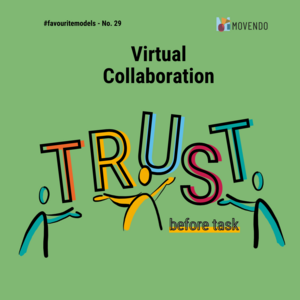#favouritemodels No. 29 - Virtual Collaboration

This has changed fundamentally in the meantime. A lot has been published about the special characteristics of virtual collaboration. Books, articles, expert how-to's - ideas and tools have been created everywhere to cope with the changed daily work routine. We at Movendo have also worked intensively with our customers on their challenges. You can find tips and impulses on collaboration 4.0 in our Whitepaper Leading Virtual Teams.
Today, after 2.5 years of experience, many teams have seen how important it is, in addition to appropriate technology and structure, to invest in their relationships in order to maintain them and the associated relationship of trust at a distance. Similarly, those who wanted to start new projects or had to form new teams during this time. With a lot of creativity and energy, ways were found together to master the new work situation.
And now? Have we arrived in the everyday life of the New Normal, in which we use collaboration tools in a competent and virtuosic way, cultivate virtual relationships and use team principles and rules to give ourselves the necessary orientation in our interaction?
Not surprisingly for today, the next challenges are already knocking on our doors, because now the leap into successful hybrid collaboration needs to be mastered. At the same time, there are more and more reports from clients who have the feeling that they are rushing through a virtual work tunnel in their everyday lives. One meeting follows the next, and in between they try to work through all the other to-dos at a rapid pace. Reports that suggest that the new normal has already become just so normal that we lose ourselves in patterns from the "good old days of presence" and assume that the cooperation and trust among each other will simply work itself out. This is not the case!
We must not forget that the challenges posed by the virtual working world to our collaboration and communication are a constant. Social interaction and the cultivation of relationships do not simply happen on the side, but must be actively planned and regularly triggered. I would therefore like to take this opportunity to remind you of a guiding principle that is of essential and ongoing importance in virtual collaboration: "Trust before Task". For us at Movendo, this mindset runs as a guardrail throughout our project work, but is especially central to our internal collaboration.
We thus put the relationship level before the factual level in our interactions or, to put it another way, the relationship orientation before the factual orientation. You could also say, "Trust takes precedence." Ultimately, an attitude that is powerful in terms of collaboration quite generally and has also been well described scientifically in the concepts of Steven Covey and Lencioni. If you're interested in Stephen M.R. Covey's model, you can find our #favouritemodel No. 6 "How trust is built" on it.
Especially now, when the diversity of work concepts is increasing once again and individual hybrid contexts are developing, the work on relationships is becoming even more complex for collaboration, and the quality of relationships is becoming even more important for team cohesion and team leadership. It is the level at which connectedness is created and maintained in the team. Especially when some are present on site and have direct contact, while others work remotely and are excluded from the newfound ease of interpersonal interactions.
How does my #favouritemodel help you?
On the one hand, the last few years have led to a steep growth in technical competence in teams and have diminished many inhibitions, doubts and fears in dealing with digital communication channels. But the personal contact and informal exchange that often happens by chance in the office and that simply, as if incidentally, leads to familiarity and trust among one another there, is still not a given in the virtual work context.
Despite the new work routine, it remains a necessity for you to consciously and actively ensure, with the help of the technical possibilities, that a short conversation here, a small gesture and a shared laugh there, has its space. If you or your colleagues feel that these facets are now giving way to issue and fact orientation, it may be time to ask again the question together, "What do we need to get out of this tunnel and be more with each other again?"
It may help to reactivate one or the other routine, such as the weekly check-in or coffee chat that helped you 2.5 years ago and may have been forgotten in the meantime. Or maybe it's the simple realization that it's finally time for a face-to-face meeting on site or a real team event. It is crucial that you remain in communication with each other, encourage exchange and create a team atmosphere in which it is easy for everyone to address critical points.
So in your meetings, continue to take explicit time for you as a team and share what's on your mind, what's going well and what's not so much, or what tensions you're noticing right now and what ideas you have as a team to resolve them.











